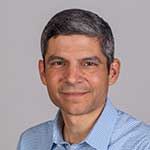Designing for Disruption
MPM students heard WSP Senior Vice President David Odeh's blueprint for ‘future-ready structures.’
The built environment sector must adapt to keep pace with a rapidly changing world beset by climate change and calls for increased sustainability.
That was the central message from David Odeh, senior vice president and national director of building structures at engineering consulting company WSP, in a recent talk to students in Northwestern Engineering's Master of Project Management (MPM) program.
 WSP is one of the largest professional service firms in the world, with more than 70,000 employees in 500 offices serving 39 countries.
WSP is one of the largest professional service firms in the world, with more than 70,000 employees in 500 offices serving 39 countries.
Odeh, who leads the structural engineering team for the firm's building projects across the United States, outlined an emerging framework he called “future-ready structures.” The concept calls for rethinking how buildings are designed and constructed to better withstand uncertain challenges such as climate change over their multi-decade lifespans.
"Every project will have unique challenges, but this framework considers design through four key lenses: sustainability, resilience, reusability, and adaptability,” said Odeh, who joined WSP in 2022 after it acquired his company, Odeh Engineers. “A key lesson is that engineers must think strategically about the long-term impact of their work.”
Odeh went on to explain the significance of each of the four lenses.
- Sustainability focuses on reducing the immense carbon footprint of construction through greener building materials and techniques.
- Resilience means fortifying structures against intensifying natural disasters fueled by climate change.
- Reusability emphasizes extending a building's useful life by making it easier to renovate or repurpose in the future.
- Adaptability allows for more flexibility to reconfigure interior spaces as needed.
"Uncertain and potentially disruptive trends such as climate change must drive change and innovation in our design process,” Odeh said. “Ultimately, we will need the profession to advance the implementation of new concepts and technology in the design of infrastructure.”
While talking about intensifying climate risks can be sobering, Odeh expressed optimism about the opportunities ahead in the built environment sector. He pointed to innovations such as new sustainable materials, modular construction techniques, and advanced digital design tools powered by machine learning.
Realizing the full potential of these new techniques and approaches will require continued investment in research, updated codes and standards, and better training to equip the next generation of engineers and designers with the right skills.
"Digital literacy, especially the application of machine learning to problem solving, is especially important in structural engineering," Odeh said. "Structural engineers must have a working knowledge of probability theory and its application to engineering problems."
Odeh encouraged MPM students looking to shape the built environment sector to explore different specialties, stay curious, and be creative problem-solvers.
"Great engineers ask a lot of questions and listen carefully to understand the project brief and respond with creative ideas," he said. "Structural engineering is a lifelong pursuit and requires continuous learning."
As the threats of climate change intensify, fundamental changes may be required for how buildings and infrastructure are designed and constructed. Odeh's concept of "future-ready structures" provides a framework for engineers and architects to create more sustainable, resilient, and adaptive projects able to meet unpredictable challenges head-on.
Odeh said he was encouraged by the caliber of students he saw in the MPM program and their abilities to tackle those challenges.
“There are numerous paths to explore in the industry based on a student's interest and passions,” he said. “MPM students were engaging, asked many good questions, and fostered a thoughtful conversation about the topics.”

